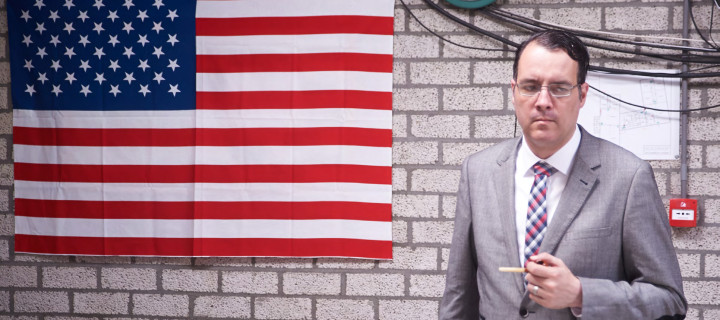In July 2014, 30 players in the Netherlands split into two groups of 15 and allowed themselves to be all but locked up during two of the hottest days of the week. They were playing a larp game called Exit, the third installment in a series exploring interpersonal tension in enclosed spaces. This game was situated in the early sixties, in a cold war bomb shelter.
Like in the previous installments there were no game masters present at all during the run time: all communications to influence the game direction and pacing were given per phone, speaker and a period-like machine made out of a receipt printer. The organizers kept track of the game through cameras and microphones. This way the illusion of being disconnected from the outside world was preserved.
We were lucky to have two large, separate rooms with facilities. The first Exit was only playable for about 15 participants, with many more regretting not being there. In the second game we tried to fix this by doing two runs back-to-back in one weekend, but that significantly reduced the playtime of each run. This time we decided to do a parallel run of two games, which was challenging, but worked out really well.
Characters
 The story started when the players awoke on Saturday morning and lasted until late in the afternoon on Sunday, after which there was some time for debriefing. Friday evening was spent socializing and doing some workshops, both for fleshing out character quirks and relationships and for communicating out of game fears and limits, since we know from experience these games can get pretty heated.
The story started when the players awoke on Saturday morning and lasted until late in the afternoon on Sunday, after which there was some time for debriefing. Friday evening was spent socializing and doing some workshops, both for fleshing out character quirks and relationships and for communicating out of game fears and limits, since we know from experience these games can get pretty heated.
In the previous games we had players send in three one-line concepts, and we would pick the ones that we thought best contributed to the overall drama and let them flesh those out.
This time the characters would not meet for the first time when the game started; they were already part of a close-knit community. That called for a somewhat different approach.
We did again not have pre-written characters, but we did have pre-written roles in the cast: there was an upper class family, a working class family, a childless couple, an outsider couple (players could choose why those two did not fit in), a lone weirdo in the house on the corner and three coincidental passers-by, who were the most unrestricted in making their concept.
We cast everybody in one of these roles while allowing for their preferences, and then had them make online connections with the players of their families and neighbors on their own. To make sure that people had intersecting secrets we gave all the players two Dread-style questions, like „what are you hiding in the attic?“, thus establishing the existence of secrets without deciding on the nature of those secrets.
Setting
 The comparison with the Nordic larp Ground Zero is pretty easy to make, but apart from the setting the games are probably pretty different in intention and feel.
The comparison with the Nordic larp Ground Zero is pretty easy to make, but apart from the setting the games are probably pretty different in intention and feel.
In Exit, it was pretty clear from the beginning that there was no massive nuclear attack going on outside. Instead of that we opted for an apparent virus outbreak: the players could just wait for it to be over. The reason is that we did not want to explore the narrative of coming to terms with one’s imminent death and the loss of civilization. Instead, the Exit series has so far always been pretty Sartrian: the overarching theme is how the dynamics of a group of people are affected by a stressful situation. The answer, it turns out, is that those groups become pretty dysfunctional after a while.
Mind you, we would of course never dare claim that the Exit series provides actual insights in that regard. There are not many full-weekend one-shot events in the Netherlands, so most people take their chance to try the concepts they always wanted to try but think unworkable for an ongoing series.
That means the cast usually consists of an over-average amount of characters in extreme situations or with extreme opinions in terms of status, religion, sexuality etc. This is in no way discouraged by us, and it does contribute to a more volatile situation and thus, more drama. On top of that people of course aim to escalate instead of subdue their conflicts. They know that a secret that is still a secret at the end of the game is a missed chance.
 This time the players really went all out in including typical Sixties themes like the communist scare, emerging feminism and the American Dream. But there was also a lot of emphasis on more personal stories of addiction, betrayal, missed chances and shattered dreams. Some people had secrets as a family, others had deliberately kept things from their loved ones, like the mother in an upper class family who dabbled in witchcraft, or the young woman who had an affair with the man next door.
This time the players really went all out in including typical Sixties themes like the communist scare, emerging feminism and the American Dream. But there was also a lot of emphasis on more personal stories of addiction, betrayal, missed chances and shattered dreams. Some people had secrets as a family, others had deliberately kept things from their loved ones, like the mother in an upper class family who dabbled in witchcraft, or the young woman who had an affair with the man next door.
Sometimes small props and gestures add a lot to the atmosphere: propaganda posters, flags, and food that added to the feeling of being in a shelter: boxes of canned food (including the rather dreaded canned bread) that the players of course had to prepare themselves. We played the Star Spangled Banner multiple times over the radio, and put the text on the wall of the bunker so everyone could sing along. The players couldn’t get it out of their heads for days afterwards.
Player Input
 The few points for improvement that were mentioned by player reviews were mainly about the fact that we had no planned moments for escalation, no specific moments for the players to take the spotlight. Some of them would have liked something to encourage them to find the right moment.
The few points for improvement that were mentioned by player reviews were mainly about the fact that we had no planned moments for escalation, no specific moments for the players to take the spotlight. Some of them would have liked something to encourage them to find the right moment.
We deliberately chose not to do that. The reason is that we like to keep Exit easy to organize so we can create an episode every year alongside our other organizational duties, and writing a plot instead of just inciting incidents would increase this workload. But also because of the fact, that for every one of the three Exits we have decreased the amount of organizer input and have exchanged it with encouraging players to create conflict and play through their characters. We are curious to see what happens as we do that.
The first Exit actually had a plot of sorts, the second one had challenges for the players, and both worked with a system where they had to collect, or fight over, tokens that seemed essential to their characters’ success. This Exit had none of that, there were only some radio fragments and a protocol for the bunker with things like physical exercises and other drills that the characters could perform.
The content that we provided was very well received, especially the radio speeches by the president (some nice amalgams of actual Kennedy quotes), but there was not much of it and most of the time the players were left to their own devices.We were happy to notice that it still worked.
 We are still looking for the perfect way to challenge players towards making great secrets and connections, and to make sure they do not leave this step until the last few days.
We are still looking for the perfect way to challenge players towards making great secrets and connections, and to make sure they do not leave this step until the last few days.
Maybe more and better workshops are the answer, or those workshops might even provide an alternative character creation process.
We did workshopping for the first time for this Exit. This is another possible point of improvement. The organizers were not very familiar with workshops outside of the usual improv exercises to get warmed up for playing. Something that didn’t help is that one of the organizers who dug into the workshopping aspect has the most unfortunate habit of not writing stuff down, and got sick so she could not be there for the game.
Overall the players were positive about workshops on Friday, but the nature of the workshops could use some improvements.
Reflections
 The previous two installments of Exit took place in a medical research centre and a Big Brother style camera house, respectively. In each one we tweaked different aspects of the game. We plan to keep doing this for a long time to come, after all there are many more interesting closed settings, from prisons to space stations.
The previous two installments of Exit took place in a medical research centre and a Big Brother style camera house, respectively. In each one we tweaked different aspects of the game. We plan to keep doing this for a long time to come, after all there are many more interesting closed settings, from prisons to space stations.
Exit 3 was the first (but possibly not the last) installment exploring an actual historical period. The fact that Exit attracts mature players who expect drama makes it an easy try-out space for new ideas.
Another thing that was different this time, as mentioned before, is the fact that most characters already knew each other. This worked really well to immediately create tension. On the other hand there is something to say for being in a tough situation with strangers as well. We may have to alternate in the future.
A few weeks after the game I was discussing it with a player. I expressed my surprise at the fact that there are not more people in the Netherlands who run concepts like Exit, since it can create good, original games without too much organizing hassle. He said he could imagine that other people wouldn’t want to do all the hard work of matching and tweaking all those characters together so that the drama would maximize. He found it hard to imagine we didn’t.
And it made me proud to have inspired such a talented cast of players to create such an intense experience amongst themselves. We told them to create their own backgrounds, their own secrets to be exposed and just go nuts. And nuts they went.
Exit 3: The Bunker
Credits: Evolution Events, René van den Berg, Karijn van der Heij, Brenda Hellenthal, Matthijs Kooijman, Cora Korsman (shared responsibility for game design, character creation assistance and game logistics)
Date: July 25 – 27, 2014
Location: Hunsel, The Netherlands
Length: 3 days
Players: 30 in total (two groups of 15 playing simultaneously)
Budget: €1,800
Participation Fee: €55
Game Mechanics: Freeform larp with almost no game mechanics
Website: http://evolution-events.nl/algemeen
This article was initially published in The Nordic Larp Yearbook 2015 published by Rollespilsakademiet and edited by Charles Bo Nielsen, Erik Sonne Georg, et al.
Cover photo: Sometimes a room needs little more dressing than a flag and player costumes will do the rest (Play, Ork de Rooij)
Other photos by Evolution Events and Eline S.






